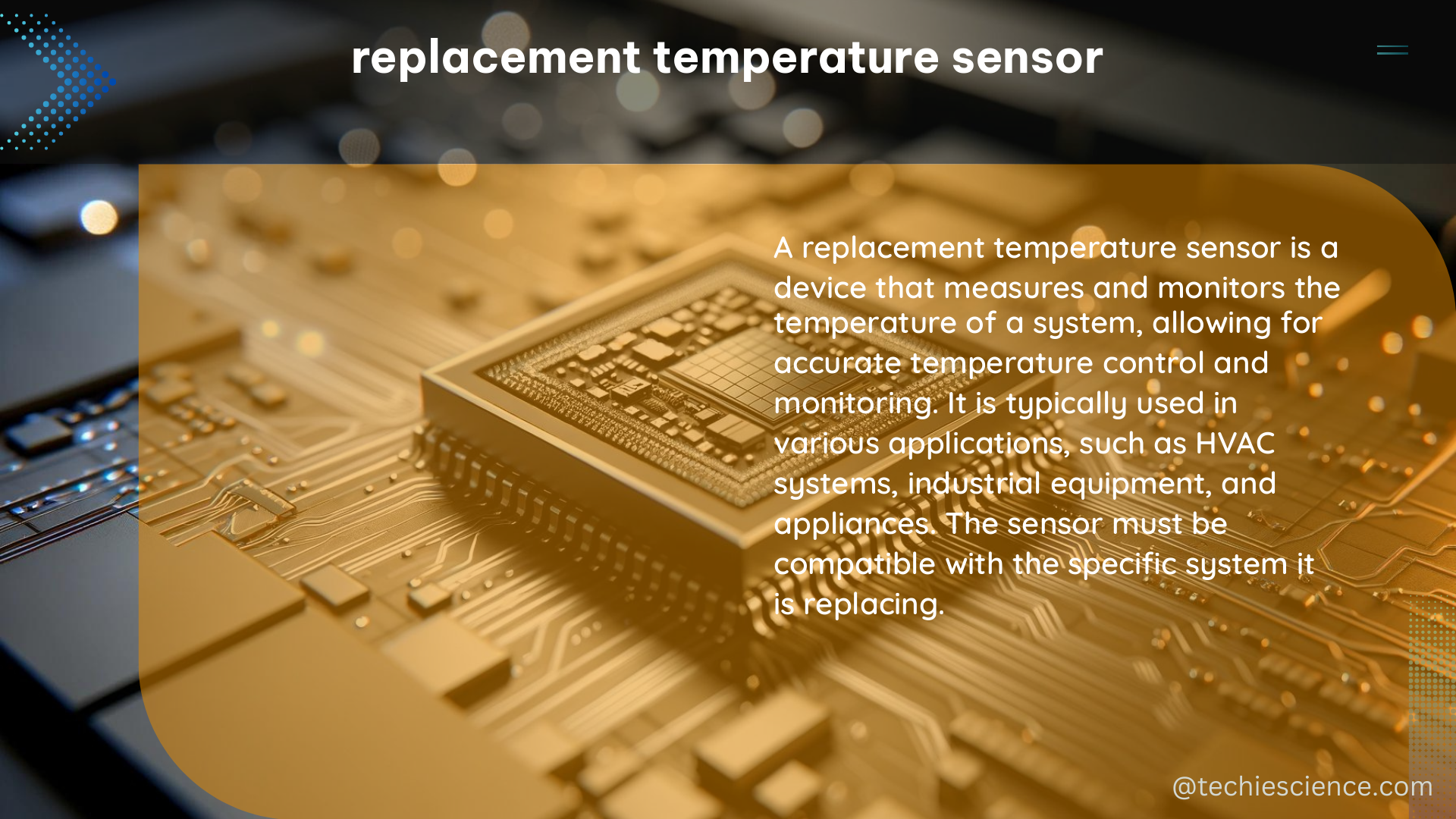Replacement temperature sensors are essential devices used to measure the temperature of a medium, typically replacing faulty or outdated sensors. The selection of the appropriate temperature sensor depends on various factors, including the temperature range, required precision, and the properties of the medium being measured.
Temperature Range and Accuracy
One of the primary considerations when selecting a replacement temperature sensor is the temperature range it can accurately measure. Thermocouples, for instance, can measure temperatures ranging from -200°C to 2000°C, while Resistance Temperature Detectors (RTDs) are typically limited to a range of -200°C to 650°C. The accuracy of these sensors also varies, with RTDs offering a higher degree of accuracy, typically within ±0.1°C, compared to thermocouples, which have an accuracy of around ±2°C.
Response Time and Time Constant

The response time of a temperature sensor is the time it takes for the sensor to reach 99.3% of the total step change in the measured property, also known as the measurand. This response time is directly related to the sensor’s time constant (τ), which is the time required for the sensor’s reading or output to reach 63.2% of its total step change in the measurand. For optimal performance, the response time should be considered, as it can vary significantly between different sensor types and applications.
Sensitivity and Repeatability
The sensitivity of a temperature sensor is the ratio of the change in the output signal to the change in the measured property. RTDs have a sensitivity of around 0.4 Ω/°C, while thermocouples have a sensitivity of approximately 40 μV/°C. Additionally, the repeatability of a sensor, which is its ability to reproduce output readings when the same value of the measurand is applied repeatedly under the same conditions, is an important factor to consider.
Stability and Linearity
The stability of a temperature sensor, or its ability to maintain its performance over time and under various environmental conditions, is crucial for reliable and consistent measurements. Similarly, the linearity of the sensor, which is the degree to which the output signal is directly proportional to the measured property, should be evaluated to ensure accurate and predictable readings.
Hysteresis
Hysteresis is the maximum difference between output readings for the same value of the measurand, depending on whether the value is increasing or decreasing. This phenomenon can affect the accuracy and reliability of temperature measurements, and should be considered when selecting a replacement sensor.
Application-Specific Considerations
When choosing a replacement temperature sensor, it is essential to consider the specific requirements of the application, such as the temperature range, required precision, response time, and the properties of the medium being measured. For instance, if high precision is critical, an RTD may be a better choice than a thermocouple. Conversely, if the temperature range is wide, a thermocouple may be more suitable.
Sensor Types and Characteristics
There are several types of temperature sensors, each with its own unique characteristics and applications. Some common types include:
-
Thermocouples: Thermocouples are widely used due to their wide temperature range, ruggedness, and relatively low cost. They generate a small voltage proportional to the temperature difference between the two junctions.
-
Resistance Temperature Detectors (RTDs): RTDs are known for their high accuracy, stability, and linearity. They measure the change in electrical resistance of a metal, typically platinum, as the temperature changes.
-
Thermistors: Thermistors are temperature-sensitive resistors that exhibit a large change in resistance with a small change in temperature. They offer high sensitivity but have a more limited temperature range compared to thermocouples and RTDs.
-
Semiconductor Temperature Sensors: These sensors, such as integrated circuit (IC) temperature sensors, use the temperature-dependent characteristics of semiconductor materials to measure temperature. They are known for their high accuracy, fast response time, and ease of integration with electronic systems.
-
Infrared (IR) Sensors: IR sensors measure the infrared radiation emitted by an object, allowing for non-contact temperature measurement. They are useful for applications where direct contact with the measured object is not possible or desirable.
Each sensor type has its own advantages and disadvantages, and the choice of a replacement temperature sensor should be based on the specific requirements of the application, as well as factors such as cost, durability, and ease of integration.
Conclusion
Selecting the appropriate replacement temperature sensor is crucial for ensuring accurate and reliable temperature measurements in a wide range of applications. By understanding the key characteristics of temperature sensors, such as temperature range, accuracy, response time, sensitivity, stability, and linearity, you can make an informed decision that meets the specific requirements of your application. This comprehensive guide provides a solid foundation for selecting the right replacement temperature sensor for your needs.
References:
- Stack Overflow, “How to subtract temperature effects from sensor data?”, https://stackoverflow.com/questions/77176312/how-to-subtract-temperature-effects-from-sensor-data
- ScienceDirect, “Sensor System – an overview”, https://www.sciencedirect.com/topics/materials-science/sensor-system
- ScienceDirect, “Detection and quantification of temperature sensor drift using probabilistic neural networks”, https://www.sciencedirect.com/science/article/pii/S0957417422019029
- Barani Design, “Difference between sensor response time and sensor time constant”, https://www.baranidesign.com/faq-articles/2019/5/6/difference-between-sensor-response-time-and-sensor-time-constant-tau
- Engineering LibreTexts, “3.2: Temperature Sensors”, https://eng.libretexts.org/Bookshelves/Industrial_and_Systems_Engineering/Chemical_Process_Dynamics_and_Controls_(Woolf)/03:_Sensors_and_Actuators/3.02:_Temperature_Sensors

The lambdageeks.com Core SME Team is a group of experienced subject matter experts from diverse scientific and technical fields including Physics, Chemistry, Technology,Electronics & Electrical Engineering, Automotive, Mechanical Engineering. Our team collaborates to create high-quality, well-researched articles on a wide range of science and technology topics for the lambdageeks.com website.
All Our Senior SME are having more than 7 Years of experience in the respective fields . They are either Working Industry Professionals or assocaited With different Universities. Refer Our Authors Page to get to know About our Core SMEs.